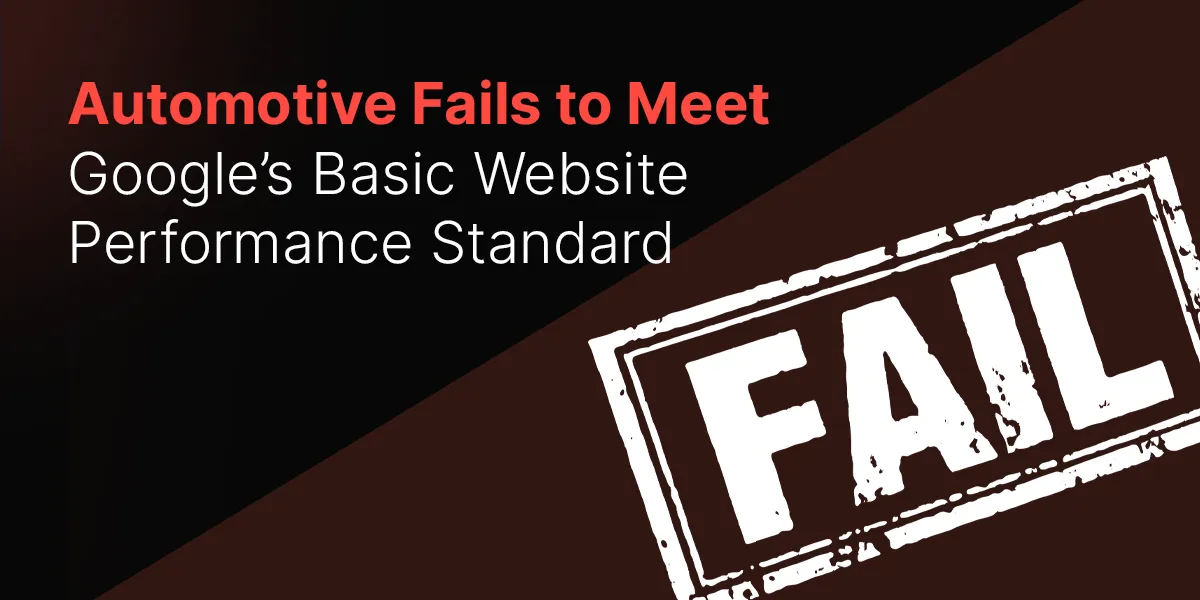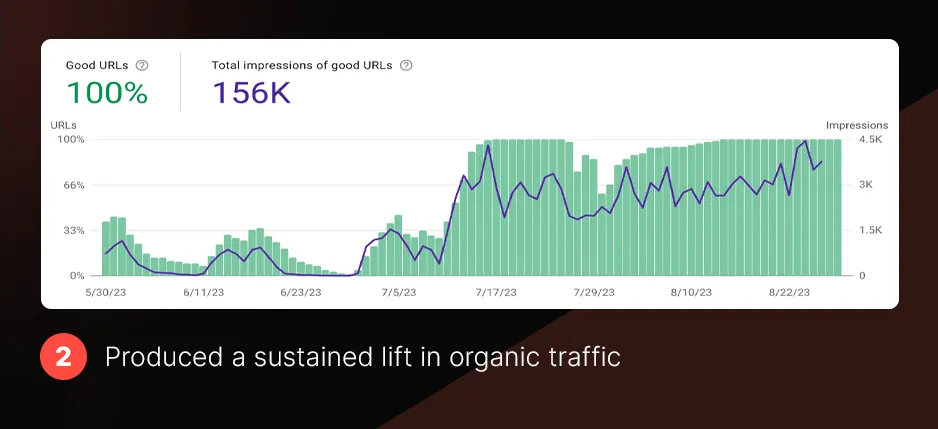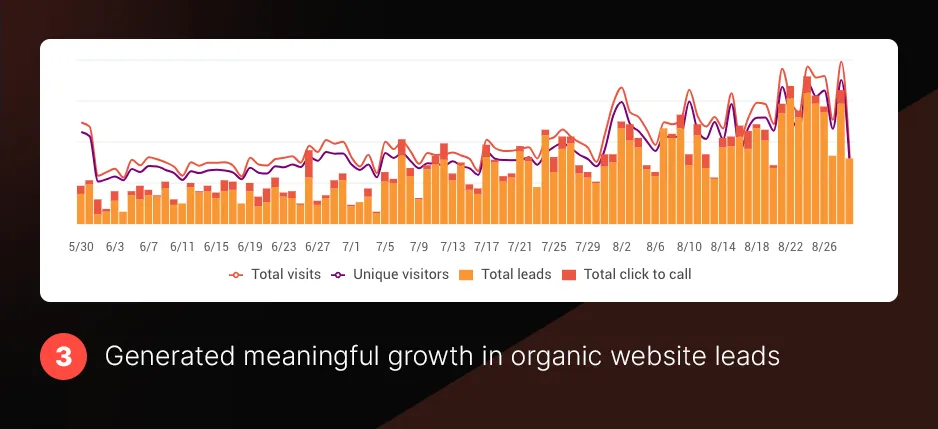Automotive Fails to Meet Google’s Basic Website Performance Standard
Joe Montgomery September 9, 2024

Executive Summary
The U.S. automotive industry plays a crucial role in the national economy, contributing roughly 3% to the gross domestic product (GDP) and representing the largest manufacturing sector. It serves as a key indicator of economic health and consumer spending patterns. As car buyers increasingly conduct extensive online research before visiting dealerships or purchasing online, understanding how Automotive Original Equipment Manufacturer (OEM) brands and dealers are adapting to this behavioral shift is essential.
How are automotive OEM brands and their dealers meeting consumer needs when it comes to the online shopping experience? How do the most sophisticated and well-funded dealer groups, often supported by top marketing consultants and agencies, approach the online consumer experience? How viable are the market leaders in dealer website technology for meeting Google’s basic performance and experience standards? And what is the impact of rampant third-party plugins on site performance and user experience?
To answer these questions, Overfuel conducted its inaugural study of websites operated by the top 50 automotive groups in North America, as defined by the Automotive News list of “Top 150 Dealership Groups (2024).” Overfuel examined publicly available Google Chrome User Experience Report data to assess whether a website’s mobile and desktop versions passed or failed Google’s Core Web Vitals Assessment in Origin Summary mode. Overfuel surveyed 2,657 dealer websites in July 2024, excluding any collision, service and parts websites.
What are Google Core Web Vitals and CrUX?
In May 2020, Google launched a new basic standard assessment for website performance and user experience: the Core Web Vitals Assessment (CWV). Websites are measured on both mobile and desktop devices.
CrUX is the official dataset of the Web Vitals program. All user-centric Core Web Vitals metrics are represented.
Chrome UX Report, Chrome for Developers, 2024
CrUX data is collected from real browsers around the world, based on certain browser options which determine user eligibility. A set of dimensions and metrics are collected which allow site owners to determine how users experience their sites.
The data collected by CrUX is available publicly through a number of Google tools and third-party tools and is used by Google Search to inform the page experience ranking factor.
With more than four years of the basic standard active, Overfuel examined the performance of top automotive groups.
Failure to Meet Customer Needs

Shockingly, less than 1% of the dealer sites Overfuel audited passed Google’s CWV for mobile and desktop. The results place this sophisticated subset of automotive dealers among the worst-performing online retail experiences available for consumers.
The failure of automotive OEMs to ensure their franchisee websites adhere to crucial website standards damages consumer trust while negatively impacting sales
Alex Griffis, CTO & President Overfuel
and brand reputation.
Common issues causing website failure:
- Bloated website code from website vendors
- Under-resourced hosting infrastructure
- Third-party plugins, with chat plugins and cookie banners being the most common offenders
- Use of oversized images and videos
- Overuse of Google Tag Manager and Google Analytics containers
The Rewards of Passing Core Web Vitals
The analytics below are for an automotive dealer whose site failed CWV, then transitioned to Overfuel and passed CWV. The site launch date with Overfuel was July 4, 2023.



Market Leaders Struggling to Find Consumer Fit
Three identified website providers were responsible for 75.7% (2,029) of the websites analyzed from the top 50 automotive groups. Given the walled-garden approach of most automotive OEMs mandating or approving the technology vendors allowed to sell into their franchisee pools, it is not surprising three legacy website vendors are responsible for two-thirds of the websites from this subset.

Additionally:
- 27 total website vendors were identified, although not all dealer sites listed a vendor
- 10 website vendors identified here represented a single website within this group
Most Third-Party Plugins in Automotive Create Performance Challenges
Some website vendors may possess the technical ability to deploy a site that passes CWV but can ultimately fail due to the third-party plugin requirements demanded by a GM, marketing lead or marketing consultant/agency.
Dealers are so focused on generating leads through their websites that they often overload their sites with third-party plugins. These additions can severely impact site performance, making it difficult for the site to meet Google’s Core Web Vitals standards. The result? Consumers end up wasting more time battling intrusive pop-ups rather than browsing for their next vehicle.
Tom Kerr, President, Affinitiv Advertising
Full disclosure: Overfuel has dealer sites failing CWV because someone at the dealership is forcing the use of a third-party plugin which breaks performance, against our recommendation.
Key Takeaways and Conclusions
The big 3 takeaways from the Overfuel study are as follows:
- Automotive manufacturers are approving and/or mandating consumer-facing dealer website technologies that overwhelmingly fail to meet Google’s CWV, often profiting from the sale of tech while hurting a franchisee’s ability to sell vehicles.
- Auto group leadership, store general managers and marketing leads, and most marketing consultants and agencies lack a general understanding of Google’s CWV and the negative impacts of failing the standard.
- With the largest and most sophisticated dealership groups failing site performance at such an extreme level, we fear the rest of the automotive industry does not fare much better, making automotive one of the worst-performing retailer categories in North America.
The silver lining is the sheer amount of competitive advantage on the table, which could equate to unprecedented levels of converted consumers and topline revenue annually.
Alex Griffis, CTO & President
Overfuel
As significantly more consumers devote a meaningful portion of their vehicle shopping experience to online research or purchase, automotive’s approach to website technology has reached a critical reflection point.
About Overfuel
For dealers seeking a competitive edge, our unique value lies in delivering websites that pass Google’s basic performance and user experience standard: Core Web Vitals. Our comprehensive SEO strategy goes beyond technical SEO, incorporating local-optimized content publishing, enhanced directory listings, Google Business Profile and Google Maps optimization, and review management to maximize local impact.
From day one, we’ve been dedicated to developing Google-performance-optimized replacements for outdated third-party plugins, and our commitment to innovation continues to drive us forward. Our UI/UX design is rigorously tested through ongoing heat mapping and behavioral analysis, ensuring an exceptional user experience for consumers.
Check out the Overfuel UI/UX case study featured by Microsoft Clarity (November 2023).
The Overfuel customer base includes a growing number of both OEM franchisees and independents with dealerships across North America.